Efficient UAV Path Planning with Multiconstraints in a 3D Large Battlefield Environment
Abstract
This study introduces an improved A* algorithm for the real-time path planning of Unmanned Air Vehicles (UAVs) in a 3D large-scale battlefield environment to solve the problem that UAVs require high survival rates and low fuel consumption. The algorithm is able to find the optimal path between two waypoints in the target space and comprehensively takes factors such as altitude, detection probability, and path length into account. It considers the maneuverability constraints of the UAV, including the safety altitude, climb rate, and turning radius, to obtain the final flyable path. Finally, the authors test the algorithm in an approximately 2,500,000 square meter area containing radars, no-fly zones, and extreme weather conditions to measure its feasibility, stability, and efficiency.
1. Introduction
With the development of various modern high-maneuverability air defense weapons and increasingly perfected air defense system, the capability of vehicles to break through enemy defenses at medium and high altitudes has decreased. Modern military low-altitude penetration is primarily performed by UAVs. The key lies in the path planning for UAVs [1]. Research in this area has been ongoing for many years, and several algorithms were developed for this problem.
The artificial potential field method was developed by Khatbi to plan the trajectory for the robots. This algorithm is intelligible in its mathematical description and has been widely used for real-time obstacle avoidance and smooth trajectory control [2]. However, the method has its inherent limits when applied to UAV path planning [3]; for example, in complex mountainous terrains, there are often multiple obstacles near the target point; it would result in a greater repulsion than attraction for the UAV. Thus, the UAV cannot reach the target [4]. Some researchers hoped to establish a unified potential function to solve this problem [5]; unfortunately, it still requires regular obstacle to avoid huge calculation requirements, which is nearly intolerable for real-time path planning.
Some researchers have attempted to find the solution in intelligent optimization algorithms, such as genetic algorithm (GA) [6, 7] and ant colony algorithm (ACA) [8, 9]. The former has good global searching maneuverability and can quickly find all of the solutions without falling into local optimal [7]. The latter is highly robust and good at searching for better solution [8], and their experimental results present the feasibility to solve this problem. However, these algorithms have common limits that are difficult to avoid in solving large-scale UAV path planning problems. For example, genetic algorithm is weak for local search with low efficiency in the later periods and easily reaches premature convergence [6]. Ant colony algorithm is sensitive to the initial parameters. An inappropriate setting decreases the search rate and yields poor results [9]. Furthermore, the real-time path planning of UAVs requires high efficiency and accuracy; these algorithms may not be proper solutions.
Graph search algorithms have been developed to find the optimal trajectory between two nodes on connected graphs. The greatest advantage of these algorithms, including Dijkstra, Bellman-Ford, and A* algorithms, is their straightforward implementation and low computational cost to get the optimal path, which makes it the most suitable method in theory [1]. The A* solver is one of the most widely used algorithms among them. It was developed to analyze more effectively the domain in order to avoid distributed obstacles, which is largely applicable to robotics, space exploration, and video games [10]. Though maturely used in 2D graph searching, the A* algorithm still faces some challenges in the UAV path planning in a 3D complex battlefield environment [11, 12], and previous research results may have problems as follows: (1) most experimental space was simple artificial topographies. The obstacles were few and regular, and complex threats such as radars and extreme weather conditions were not considered [13–15]; therefore, they did not verify their feasibility, efficiency, and convergence in large-scale complex space. (2) Some path planning is essentially performed in a 2D plane [16–18]. Some researchers use 2D spatial partitioning methods, like Voronoi map, to divide the target space into several sections to construct connected network graph. (3) The algorithms did not obtain a flyable path; most searching results are break lines or smoothing curves [14–17]. The maneuverability of the UAV, including the turning radius, safety altitude, climb rate, minimum step size, and fuel consumption, should be considered to get a flyable path, which is a fundamental difference from general robot path planning.
In light of the limitations above, the paper proposed an improved A* algorithm for the UAV path planning in a 3D large-scale battlefield. This space is composed of real terrain data, radars, no-fly zones, and extreme weather conditions. The algorithm considers terrain following, threat avoidance, and fuel consumption to obtain a flyable path that follows the maneuverability constraints of a UAV. Meanwhile, an assessment algorithm was designed to evaluate the final path. Finally, the algorithm was compared with ACA and GA to present its advantage.
2. Materials and Methods
2.1. Modeling of the Battlefield Environment
The target space in this paper consists of a DEM map and battlefield plot information. Because the modeling methods for the former are very mature, this paper focuses on modeling the plot information, which includes radars, no-fly zones, and extreme weather.
Radars have been widely used to detect the UAVs in modern air defense system. This paper does not treat radar like a normal obstacle but build a detection probability model, which distinguishes this research from most previous studies [19]. The process for computing the detection probability at any point in the target space is essentially the inverse of the radar equation and pattern function [20]. This value is calculated as follows.
This formula is nonlinear, so we can use the more efficient Newton iteration method [21] to determine the radar detection probability at any point in the target space.
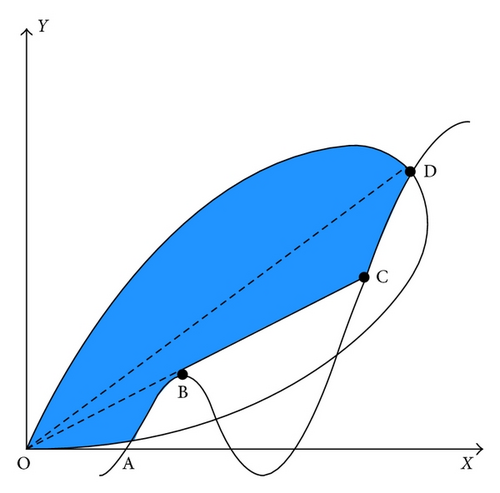

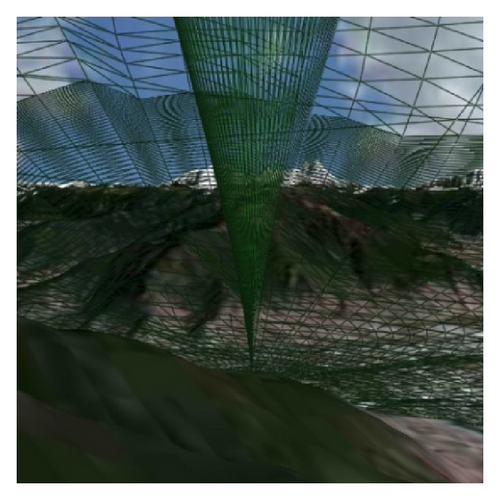
Extreme weather, including thunderstorms, blizzards, hails, hazes, and strong airstreams, poses a significant threat to the flight of UAVs. The climate threat model is divided into 2D and 3D zones based on its sphere of action. The former are described using a closed curve {Pi(x, y)}, where x and y represent the longitude and latitude, respectively, and are shown in Figure 4. The latter are described using polygonal prisms ({Pi(x, y)}, Hmin, Hmax). Hmin and Hmax are the altitude limits, respectively, and are shown in Figure 5. No-fly zones are described similarly to the 2D climate model.

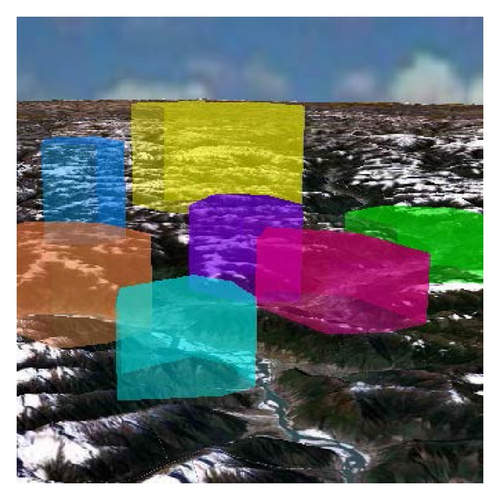
2.2. Path Planning Strategies
2.2.1. Target Space Partition
The 3D area described by the DEM and DOM is a continuous raster space; therefore, there is no node-edge graph network present in traditional path searching, and spatial partitioning can solve this problem.
Some researchers used a Voronoi diagram to partition the space at a certain altitude [22]. Because UAVs change altitude during flight, this method is only applicable to certain flight missions in flat areas with small section changes at different altitudes. However, for mountainous terrain, this method cannot obtain a valuable optimal path. In addition, some researchers tried to use regular 3D boxes for the space partitioning [14]. It means that there are at least 26 nodes to expand during the searching process, which requires a large amount of time and memory to obtain an optimal solution, especially, in large space. This paper recommends a 2.5D partition model to solve this problem. The model is actually a surface partition model, which logically divides the DEM data into a series of independent rectangular grids in some accuracy. The terrain information in a grid is represented by its center. Each center point records the longitude, latitude, and altitude, as shown in Figure 6(a). The centers form a routing network needed in the routing process. This model has only 8 directions to expand for each node, which makes it more efficient than the 3D grid partition method.
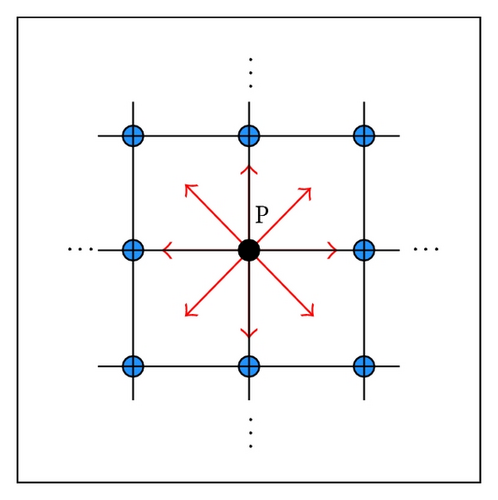
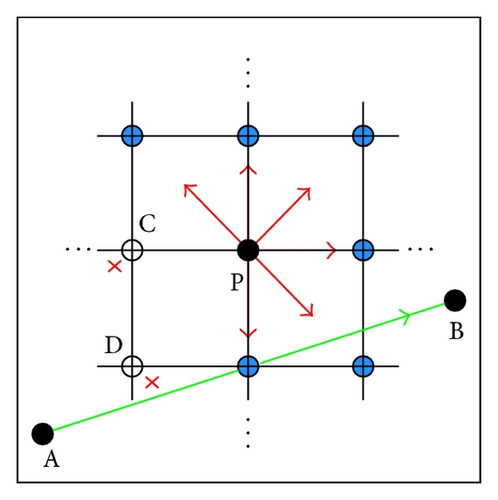

To further improve the convergence rate and efficiency of the algorithm, some researchers recommend considering the maneuverability constraints of UAVs [14, 17], including the minimum step size and turning radius, in nodes expansion. Satisfying the minimum step size requirement means increase of the grid size, which does improve the search speed to some degree, but it causes an excessive loss of terrain details and may greatly decrease the accuracy of the searching result. Considering the limits to the UAV’s speed, slope, and turning angle may decrease expansion directions, but some global optimal nodes may be missed due to the fact that the grid points are not the final waypoints. However, this method can be applied in local searching to filter out directions that the angle to the global direction is too large (e.g., >150°) as shown in Figure 6(b). In addition, this method can also filter out nodes in the no-fly zone and extreme climate threat as shown in Figure 6(c).
2.2.2. Initial Path Based on the Improved A* Algorithm
This heuristic function may have some problems when applied to the subject of this paper. First, ct is a relative distance, but h is an absolute altitude, and they have differing magnitudes. The distance to the center of the threat, fTA, is positively correlated with the cost function, and the lower this value is the better it is. However, ct and h run counter to this value, which makes it not easy to assign a reasonable weight to each factor. Second, the threat of radar should be measured as a probability rather than a relative distance. Thus, it is several orders of magnitude lower than the other factors and the function would be too insensitive to ω1, ω2, and ω3, which makes finding three values to develop a meaningful cost function for determining the optimal path difficult.
In this formula, ci is the surface distance from node i to node i − 1, which is the penalty for the route length. pi is the detection probability between nodes i and i − 1 and is aimed at increasing the survival rate of the UAV. hi is the weighted average altitude between nodes i and i − 1.
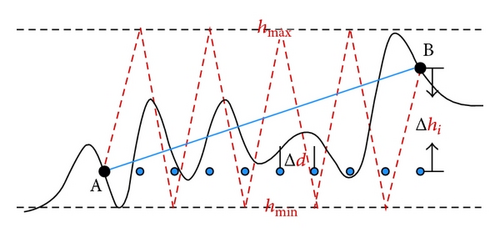
In this formula, dn, dmax, and dmin are the Euclidean, maximum, and minimum distances from node n to the target point as calculated using a similar formula to (10). However, it is worth mentioning that the sampling interval, ΔD, is generally greater than Δd to increase the efficiency of h(n).
Once the target space and cost function are set, the standard A* path searching process can begin. Open and closed lists were defined to store the expanded nodes, which were implemented with the minimum binary heap and linear lists to increase the efficiency.
2.2.3. The Path Optimization Algorithms
The search results from Section 2.2.2 may not satisfy the UAV maneuverability constraints, such as minimum step size, turning radius, turning angle, climb rate, and safety altitude. Therefore, a series of algorithms are developed to obtain the final flyable path.
The minimum step size and turning radius are constraints on the top view. The former requires the length of each route segment to be above a certain value Smin, while the latter requires every segment to be long enough for two continuous turns; therefore, we have to compress the initial route. To satisfy the two constraints, in this paper, the FFP algorithm is used for the data compression [24], and the longest rectilinear trend can be furthest preserved to avoid frequent turning of the UAV. In addition, the turning angle constraint requires every segment angle to be below a critical value, Cmin. A potential field algorithm can be developed to solve this problem [5]. As UAVs cannot fly along a broken line, some researchers recommend various curve smoothing methods such as the B-spline curve [25]. However, these methods obviously conflict with the minimum step size constraint. In fact, UAVs generally turn by escribing or flyby [26].
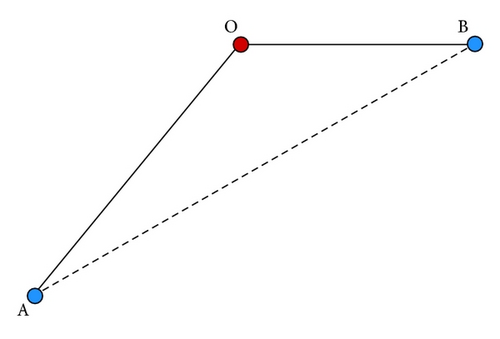
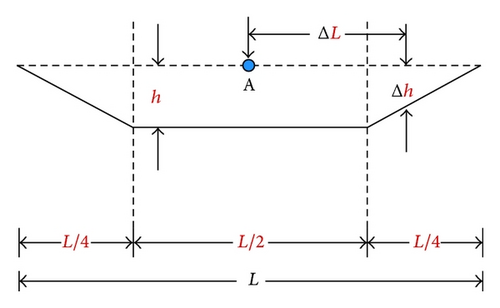
- (1)
Divide AB into AO and OB, and O is the level-flight point calculated from the climb rate at A.
- (2)
Calculate the minimum signed altitude difference, ΔH1, for the OB segment. Begin the spatial interpolation for OB to obtain a series of interpolated points, {Pi}. Divide the cross section of Pi into a primary area and two secondary areas, and calculate the corresponding minimum signed heights. Consider
(17) -
where is the minimum signed height difference for cross section Pi, hB is the altitude of the OB segment, h is the entire safety altitude, Δh is the safety altitude of the secondary areas as calculated from formula (16), hj is the altitude of the interpolation point j in the primary area, and hk is the altitude of the interpolation point k in the secondary area. The minimum value can be obtained by traversing {Pi}.
- (3)
Calculate the minimum signed height difference, ΔH2, of the AO segment. First, get the interpolation points, {Qi}, between AO by spatial interpolation, and the minimum signed height difference for cross section i of Qi is calculated by
(18) -
where hi = hA + AO*(hO − hA)/AQi, and ΔH2 can be calculated by traversing {Qi}.
- (4)
Adjust the altitude of O and B to hB + ΔH1 and the altitude of A to hA + ΔH2. Create a radial through A using the climb rate and calculate the intersection with OB, which is the new level-flight point O.
3. Results and Discussion
The test space was about 2,500,000 Km2 between Linzhi in Tibet and Chengdu in Sichuan province and was constructed with SRTM terrain and LANDSAT image data in 30 m accuracy. The area is a mountainous district that can verify the feasibility and adaptability of the algorithms in this paper. The algorithms were developed with C# and Direct 3D, and they have been successfully used for a 3DGIS platform, Gaea Explorer [27]. The hardware environment was as follows: CPU: Intel Core2 Duo E8200, memory: Kinston 1 G, video card: ATI Radeon HD 2600 XT.
To prove the feasibility of the algorithms in this paper, we developed the parameters in Table 1. Before searching, we defined the UAV parameters in Table 2.
| Starting point (°, °, M) | Target point (°, °, M) | Surface distance (KM) | Grid size (°) | ω1 : ω2 : ω3 |
|---|---|---|---|---|
| 93.832779 | 94.372746 | 59.783 | 0.01 | 1 : 2 : 1 |
| 29.127954 | 29.31984 | |||
| 2949.2 | 2923.6 |
| Speed (KM/H) | Slope (°) | Climb rate (M/S) | Turning method | Safety altitude (M) | Safety corridor width (NM) |
|---|---|---|---|---|---|
| 300 | 20 | 120 | Escribing | 300 | 2 |
In Figure 10, (a) shows the initial search result, (b) shows the compression results, (c) shows the smoothing results, (d) shows the results that consider the climb rate, (e) shows the safety corridor result, (f) shows the results that consider the safety altitude, and both (g) and (h) show the local features of the safety corridor from the top and front views, respectively. To prove the safety of the final path, we calculated the profile at ±L/4 and ±L/2, as shown in Figure 11. From these results, we determined that the algorithms were effective for low-altitude UAV path planning.
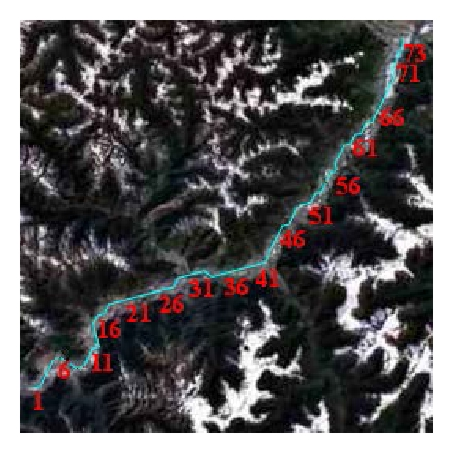
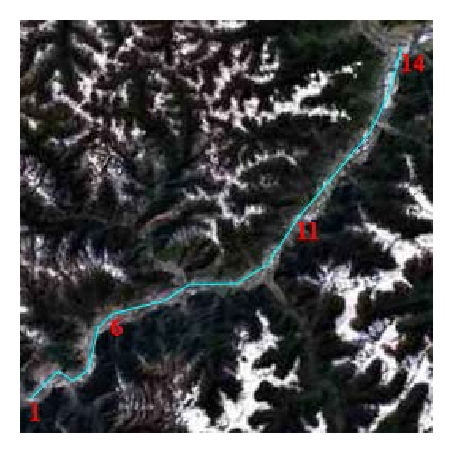
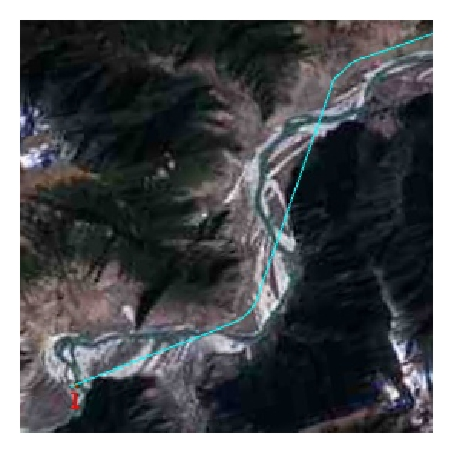

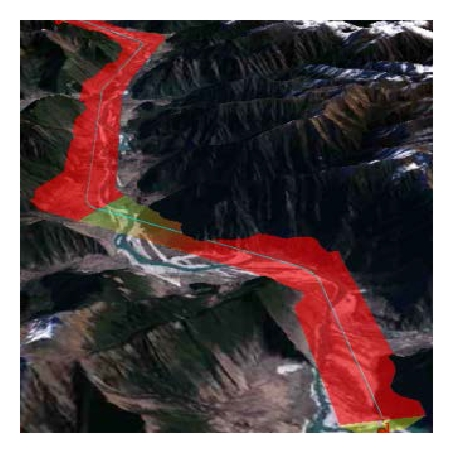
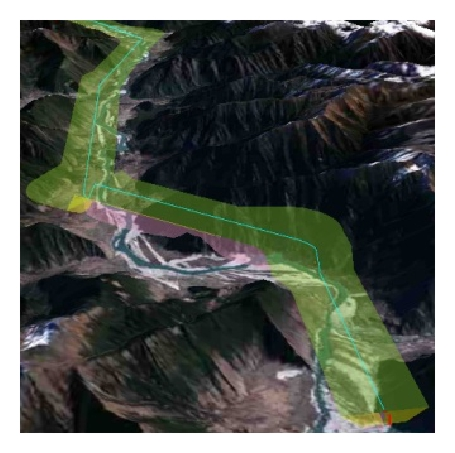
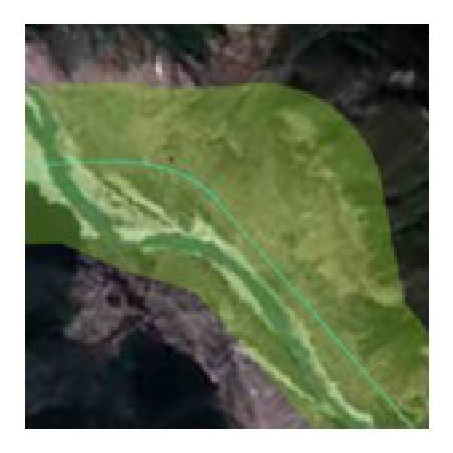
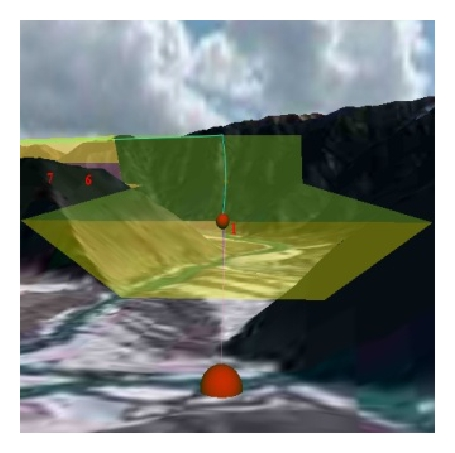
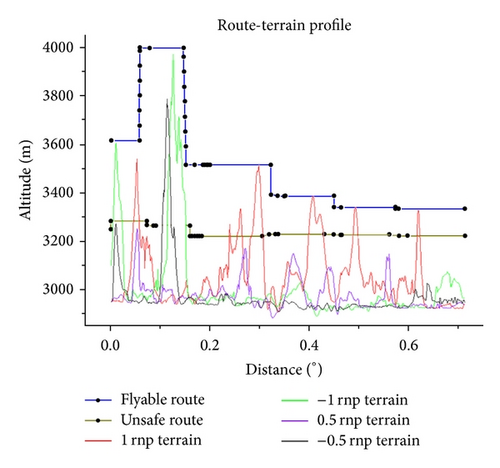
In Table 3, four experimental groups were designed to show the adaptability, convergence, and efficiency of the algorithm at various distances and grid sizes. Table 4 shows the parameters to evaluate the final path, where Haver is the average altitude of the starting point and target point.
| Starting point (°, °, M) | Target point (°, °, M) | Surface distance (KM) | Grid size (°) | ω1 : ω2 : ω3 |
|---|---|---|---|---|
| 93.832779 | 94.372746 | 59.783 | 0.005 | 1 : 2 : 1 |
| 29.127954 | 29.31984 | 0.01 | ||
| 2949.2 | 2923.6 | 0.02 | ||
| 90.739257 | 94.835207 | 419.073 | 0.005 | |
| 29.292307 | 29.506482 | 0.01 | ||
| 3606.3 | 2915.5 | 0.02 | ||
| 87.631027 | 94.816805 | 729.349 | 0.005 | |
| 29.130563 | 29.463092 | 0.01 | ||
| 3985.1 | 2914.9 | 0.02 | ||
| 93.562434 | 105.587785 | 1236.916 | 0.005 | |
| 29.168065 | 30.119375 | 0.01 | ||
| 2976.5 | 399.4 | 0.02 |
| Minimum length (KM) | Maximum length (KM) | Minimum altitude (M) | Maximum altitude (M) | ε1 : ε2 : ε3 |
|---|---|---|---|---|
| Surface distance | 2 * surface distance | Haver | 4500 | 1 : 1 : 1 |
Table 5 shows that the algorithm can quickly determine the optimal path for various distances and grid sizes, which means that the algorithm is stable, convergent, and efficient. The time cost is proportional to the distance and inversely proportional to the grid size. Furthermore, the assessment value is smaller when the space partition grid is 0.01° rather than 0.005° or 0.02°.
| Assessment value | Route length (KM) | Detection probability | Mean altitude (M) | Total calculation time (S) | ||
|---|---|---|---|---|---|---|
| Initial path | Compress and smoothen | Altitude adjusting | ||||
| 0.133043 | 60.4 | 0 | 3542.2 | 0.169 | ||
| 0.012 | 0.121 | 0.036 | ||||
| 0.129928 | 60.611 | 0 | 3528.9 | 0.129 | ||
| 0.004 | 0.086 | 0.039 | ||||
| 0.207789 | 59.932 | 0 | 3907.2 | 0.104 | ||
| 0.002 | 0.065 | 0.037 | ||||
| 0.346597 | 487.291 | 0 | 4347.6 | 4.462 | ||
| 3.19 | 0.941 | 0.331 | ||||
| 0.207219 | 441.867 | 0 | 3963.8 | 1.51 | ||
| 0.271 | 0.952 | 0.287 | ||||
| 0.395662 | 427.289 | 0 | 4707.4 | 1.138 | ||
| 0.086 | 0.774 | 0.278 | ||||
| 0.450168 | 853.568 | 0 | 4689.2 | 13.063 | ||
| 9.916 | 2.693 | 0.454 | ||||
| 0.273318 | 805.585 | 0 | 4201.2 | 3.268 | ||
| 0.543 | 2.241 | 0.484 | ||||
| 0.328756 | 778.665 | 0 | 4414.6 | 2.202 | ||
| 0.068 | 1.684 | 0.45 | ||||
| 0.323873 | 1591.054 | 0 | 3615.2 | 52.065 | ||
| 44.584 | 6.538 | 0.788 | ||||
| 0.27795 | 1521.588 | 0 | 3385.6 | 11.488 | ||
| 3.63 | 6.915 | 0.943 | ||||
| 0.294937 | 1399.922 | 0 | 3808.5 | 7.251 | ||
| 0.79 | 5.763 | 0.698 | ||||
To present the influence on the searching result of the changes of ω1 : ω2 : ω3, the four groups in Table 4 were compared at the ratio of the weight factors ω1, ω2, and ω3 being equal to 2 : 1 : 1, 1 : 2 : 1, or 1 : 1 : 1. The result in Table 6 shows that the time cost is proportional to the weight of the route length and inversely proportional to the weight of the route altitude. A higher weight of the length results in faster approach to the target point, but the UAVs would be more likely to be detected by enemies because higher nodes may be chosen in nodes extension. Considering the survival rate of the UAVs, a higher weight of the altitude may be more reasonable, and it was seemingly backed up by Table 6, which shows that the assessment value is the smallest when the weight ratio is 1 : 2 : 1 rather than 1 : 1 : 1 or 2 : 1 : 1.
| Assessment value | Route length (KM) | Detection probability | Mean altitude (M) | Total calculation time (S) | ||
|---|---|---|---|---|---|---|
| Initial path | Compress and smoothen | Altitude adjusting | ||||
| 0.189288 | 58.95 | 0 | 3846.1 | 0.132 | ||
| 0.004 | 0.091 | 0.037 | ||||
| 0.130927 | 60.611 | 0 | 3528.9 | 0.129 | ||
| 0.004 | 0.086 | 0.039 | ||||
| 0.27982 | 59.201 | 0 | 4264.2 | 0.135 | ||
| 0.003 | 0.084 | 0.042 | ||||
| 0.379233 | 413.297 | 0 | 4687.7 | 1.121 | ||
| 0.103 | 0.764 | 0.254 | ||||
| 0.207394 | 441.867 | 0 | 3963.8 | 1.51 | ||
| 0.271 | 0.952 | 0.287 | ||||
| 0.436574 | 423.076 | 0 | 4872.4 | 1.364 | ||
| 0.088 | 0.983 | 0.293 | ||||
| 0.413541 | 751.683 | 0 | 4720.5 | 2.316 | ||
| 0.261 | 1.643 | 0.412 | ||||
| 0.273318 | 805.585 | 0 | 4201.2 | 3.268 | ||
| 0.543 | 2.241 | 0.484 | ||||
| 0.482125 | 769.564 | 0 | 4910.8 | 2.58 | ||
| 0.179 | 1.875 | 0.526 | ||||
| 0.285577 | 1342.626 | 0 | 3856.8 | 6.137 | ||
| 1.327 | 4.112 | 0.698 | ||||
| 0.27795 | 1521.588 | 0 | 3385.6 | 11.488 | ||
| 3.63 | 6.915 | 0.943 | ||||
| 0.310799 | 1398.655 | 0 | 3942.2 | 7.743 | ||
| 1.158 | 5.371 | 1.214 | ||||
Figures 12(a)–12(d) show the results of the four comparison groups at a grid size of 0.01° and a weight ratio of 1 : 2 : 1.
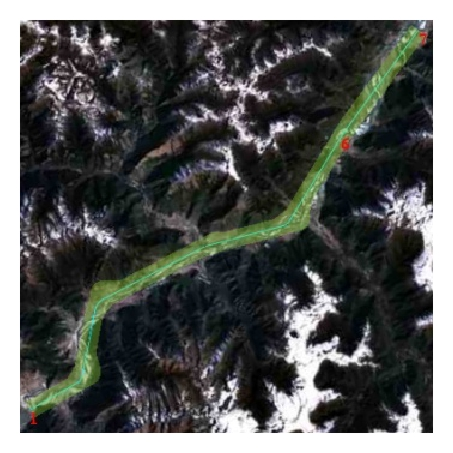
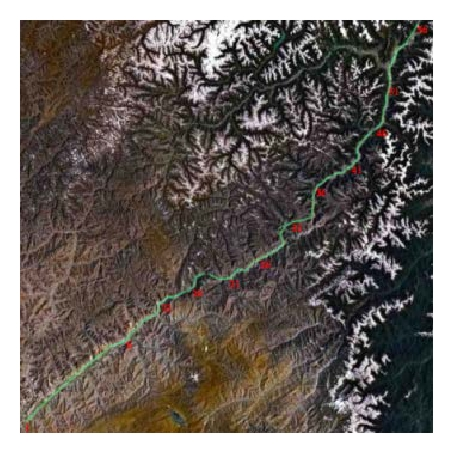
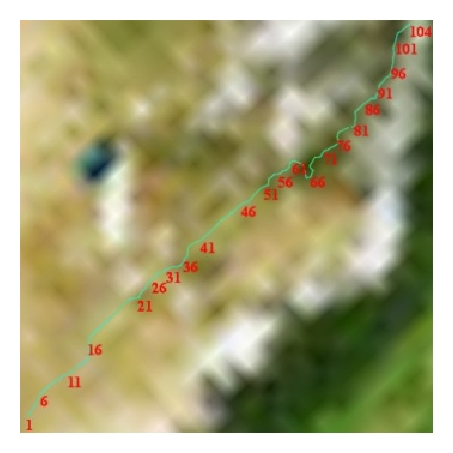
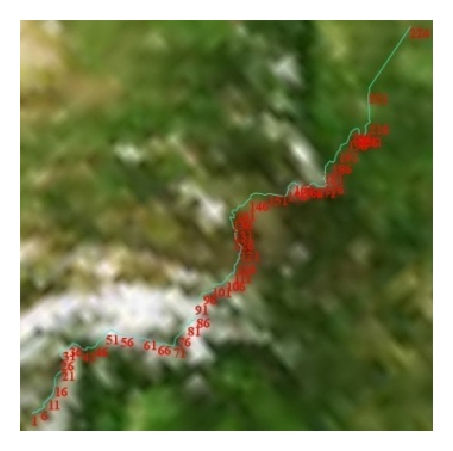
We created a battlefield environment of approximately 2,500,000 Km2, as shown in Figure 13, to demonstrate the algorithm’s adaptability and convergence for large-scale complex situations including no-fly zones, extreme weather, and radars.
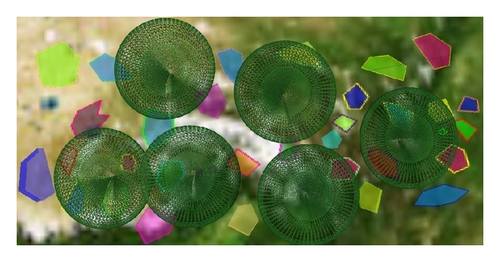
Table 7 shows the search results for the four groups at a grid size of 0.01°. The results prove that the algorithm is stable and convergent even for a complex battlefield environment. By comparing with the results shown in Table 4, we can see that the search time and route altitude increased slightly. Figure 14(a) shows the searching results for the first group; Figure 14(b) shows the local features. The other images are the results for the other three groups. These results indicate that the algorithm can effectively avoid no-fly zones and extreme weather while automatically searching for blind zones in radars network to accomplish a low-altitude penetration.
| Waypoints number | Route length (KM) | Detection probability | Mean altitude (M) | Total calculation time (S) | ||
|---|---|---|---|---|---|---|
| Initial path | Compress and smoothen | Altitude adjusting | ||||
| 22 | 143.436 | 0.0019 | 3953.1 | 0.483 | ||
| 0.093 | 0.308 | 0.082 | ||||
| 71 | 513.648 | 0.0023 | 4655.4 | 2.361 | ||
| 0.77 | 1.264 | 0.327 | ||||
| 111 | 865.65 | 0.0017 | 5133.7 | 6.048 | ||
| 2.732 | 2.871 | 0.445 | ||||
| 215 | 1592.591 | 0.0011 | 3750.4 | 19.146 | ||
| 11.998 | 6.127 | 1.021 | ||||
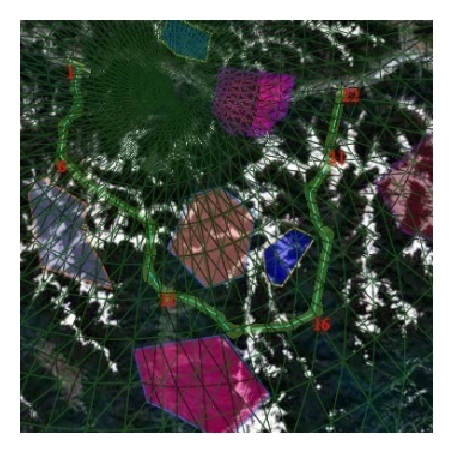
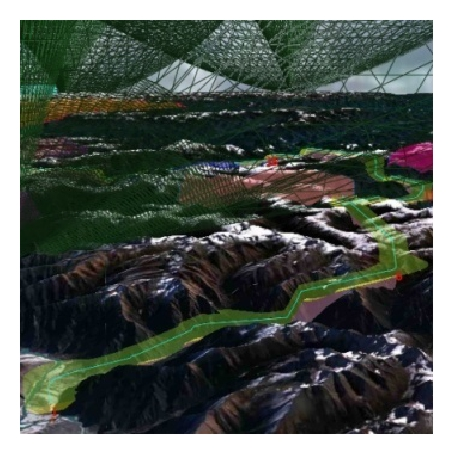
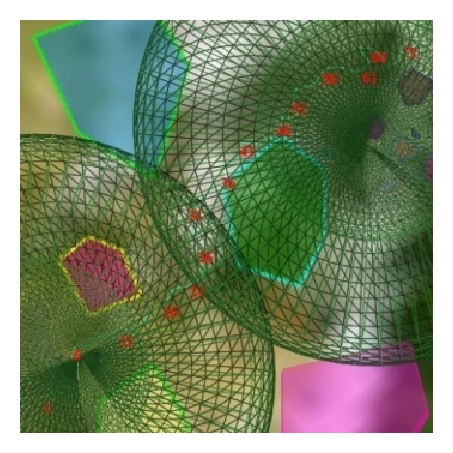
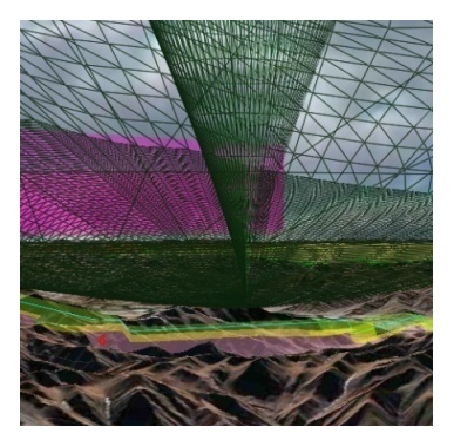
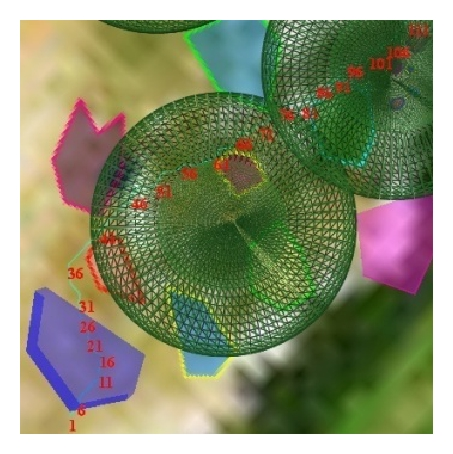
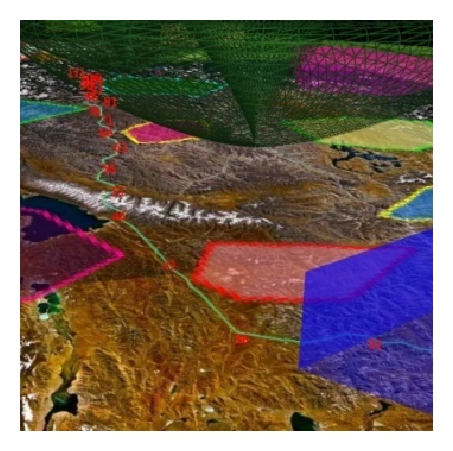
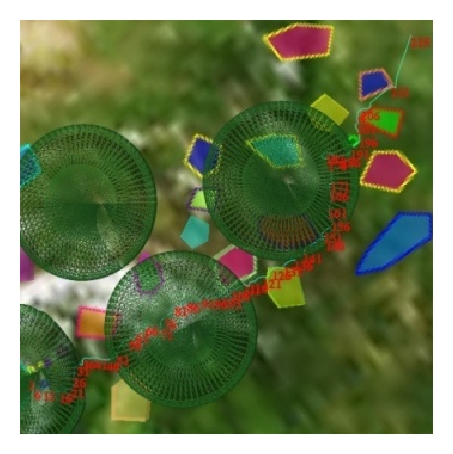
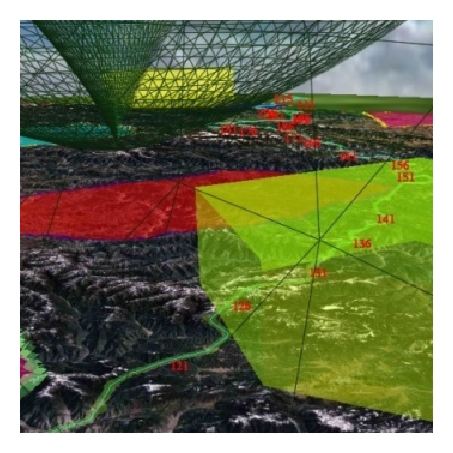
To present the advantages of the algorithm in solving the problem, we compared it with the ACA and the GA using the same parameters as in Table 3. The grid size is 0.001, and the iteration of ACS and GA is 2000.
The comparison results in Table 8 show that our algorithm has greater advantage in time efficiency than the other two algorithms, especially, in large scales, which is quite important in real-time path planning. On the surface, the advantage in the searching result is not so obvious, but the stability and convergence to get the optimal path still have comparative preponderance.
| Algorithm type | Assessment value | Route length (KM) | Detection probability | Mean altitude (M) | Total calculation time (S) | ||
|---|---|---|---|---|---|---|---|
| Initial path | Compress and smoothen | Altitude adjusting | |||||
| Improved A* | 0.130927 | 60.611 | 0 | 3528.9 | 0.129 | ||
| 0.004 | 0.086 | 0.039 | |||||
| ACS | 0.133615 | 61.678 | 0 | 3513.6 | 90.715 | ||
| 110.265 | 110.265 | 110.265 | |||||
| GA | 0.134115 | 59.898 | 0 | 3562.5 | 110.265 | ||
| 110.142 | 0.092 | 0.031 | |||||
| Improved A* | 0.207394 | 441.867 | 0 | 3963.8 | 1.51 | ||
| 0.271 | 0.952 | 0.287 | |||||
| ACS | 0.231413 | 446.073 | 0 | 4041.3 | 1396.646 | ||
| 1394.478 | 1.957 | 0.211 | |||||
| GA | 0.223132 | 450.576 | 0 | 3997.2 | 1769.705 | ||
| 1766.738 | 2.732 | 0.235 | |||||
| Improved A* | 0.273318 | 805.585 | 0 | 4201.2 | 3.268 | ||
| 0.543 | 2.241 | 0.484 | |||||
| ACS | 0.27901 | 793.658 | 0 | 4236.3 | 3652.089 | ||
| 3643.819 | 7.717 | 0.553 | |||||
| GA | 0.285504 | 799.532 | 0 | 4248.3 | 2944.994 | ||
| 2931.554 | 12.793 | 0.647 | |||||
| Improved A* | 0.27795 | 1521.588 | 0 | 3385.6 | 11.488 | ||
| 3.63 | 6.915 | 0.943 | |||||
| ACS | 0.280544 | 1496.949 | 0 | 3463.5 | 11541.301 | ||
| 10848.625 | 31.539 | 1.137 | |||||
| GA | 0.297615 | 1588.795 | 0 | 3398.7 | 7645.141 | ||
| 7570.303 | 73.15 | 1.688 | |||||
4. Conclusions
An improved A* algorithm was developed for the path planning in large-scale 3D battlefields. The paper recommended a 2.5D spatial partition method for the 3D raster space, proposed a probability calculation model for radars network, and improved the A* cost function to get an optimum route by considering the route length, the altitude, and the detection probability. A series of path optimization algorithms were developed to follow the maneuverability constraints of UAVs to obtain a final flyable path, and an assessment algorithm was designed to evaluate the path. The experimental results show that the improved A* algorithm is stable, convergent, and efficient, and the comparison with ACA and GA shows its great advantage.
However, some issues should be further discussed. First, it is not so clear to quantify the planning goal to the optimal parameters, which is the key focus of decision makers. It was indicated that a comparatively good result was obtained at a grid size of 0.01° and a weight ratio of 1 : 2 : 1, but it is not easy to determine the exact optimal value of them. Table 6 presents that the path is better when the value of ω1 : ω2 : ω3 is 1 : 2 : 1 rather than 1 : 1 : 1 or 2 : 1 : 1, but the assessment still depends on the parameters in Table 4.
Second, since the final path cannot be directly obtained by the A* process as mentioned in Section 2.2.1., the searching result after the optimization process may no longer be the optimal solution. Although we adjusted the algorithms to locally optimize the route segments, globally optimizing the entire path is still to be solved.
Finally, the comparison of the improved A* algorithm with ACA and GA shows its great superiority in time efficiency, but the advantage is not so obvious in the planning result, and more iterations of ACA or GA may even obtain better result than A* algorithm. However, considering the internal limitations of the latter, like their stability (sensitive to initial parameters), convergence, and efficiency, they need to be further studied to be used in the UAV path planning.
Conflict of Interests
The authors declare that there is no conflict of interests regarding the publication of this paper.
Acknowledgments
This work was supported by Grants from the National Basic Research Program of China (973 Program) (no. 2011CB707101), the National High Technology Research and Development Program of China (863 Program) (nos. 2011AA010500 and 2013AA01A608), the National Key Projects (2013ZX07503-001), and the National Nature Science Foundation of China (NSFC) Program (no. 2010CDB08403). The authors appreciate the support and help from both the Air Defense Commanding Troops and their research centers.




